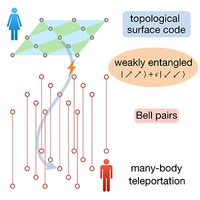The concept of teleportation has evolved from science fiction to a credible scientific principle, rooted in foundational quantum mechanics research by Bennett and others in the 1980s. Since the late 1990s, experiments have successfully demonstrated teleportation over increasingly long distances, from glass-fiber connections to links with Earth-orbiting satellites. However, achieving teleportation at macroscopic scales and beyond a few qubits has remained a challenge. Recent advancements in quantum computing hardware, which now allow for the manipulation of hundreds of qubits, have renewed optimism for this ambitious goal.
In this context, the group of S. Trebst has made a crucial contribution by developing a protocol to teleport a surface code—a widely used framework for encoding logical qubits in many physical qubits within fault-tolerant quantum computing architectures. Their research connects the teleportation process to a statistical-mechanics problem, demonstrating the protocol’s robustness against various coherent errors. A significant outcome of this work is a phase diagram that outlines the conditions for achieving completely fault-tolerant teleportation.

Notably, this innovative protocol can be readily implemented in current-generation quantum devices, including transmons, ion-based “noisy intermediate-scale quantum” (NISQ) systems, and reconfigurable Rydberg-atom setups. This opens the door to the experimental realization of many-qubit teleportation in the near future, marking an exciting advancement in the field of quantum computing.
